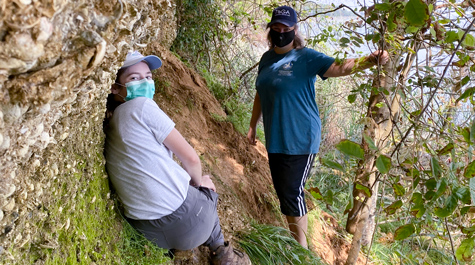Tectonic shift in geosciences professions spikes interest in geology major
Heather Macdonald was almost as happy as if she had found a kimberlite pipe.
A kimberlite pipe is a rare geological formation that slowly churns diamonds up to the Earth’s surface. Macdonald, Chancellor Professor in William & Mary’s Department of Geology, discovered another kind of rarity as she was preparing for the fall semester.
“All five of my freshman advisees this year want to be geology majors,” Macdonald said. “That’s unheard of!”
She added that in a typical year, a single new student — two at the most —will announce their intention to major in geology. All told, some 10 members of William & Mary’s class of 2025 have said they are interested in a geology major.
“This year is a bumper crop. It is just incredibly unusual,” Macdonald said. “And I don’t know exactly why. It’s completely phenomenal.”
As is the case with a number of disciplines and at colleges and universities across the country, students who graduate with degrees in geology often enroll intending to take up another line of study, she said — pre-med, biology, environmental science or chemistry.
Macdonald added that students who end up as geology majors at William & Mary usually learn about the wonders and possibilities of the geosciences through an introductory course or a field experience.
Geology Department Chair Rowan Lockwood explains why geology is so often a “discovery major.” First of all, there are a number of misconceptions out there.
“I think a lot of students — and their families — assume that the easiest career paths are the professional tracks,” she said. “They can slot themselves right into medicine, dentistry, or law or engineering or business. It’s very easy to see those tracks. I think there are lots of other tracks, including geology, where it's harder to see the path.”
In addition, Lockwood said many people assume the geology path leads mainly to jobs in the fossil-fuel industry.
“That could not be further from the truth,” she said. “The oil industry these days employs comparatively few geologists. The vast majority of geologists work in the environmental sector. The GIS and hydrology sectors are booming.”
Lockwood added that Forbes ranked geology among the top 13 most marketable majors. Today’s hot job market is the result of a tectonic shift in the geosciences industry.
“When I was just getting my undergraduate degree, the bottom had fallen out of the oil industry,” she said. “And so there was very little marketability for a geology major, because the environmental geology side of things hadn’t boomed yet.”
The William & Mary geologists have been mindful that prospects for geologists have become wider and deeper. Macdonald said that Linda Morse, a senior lecturer in the department, teaches a course on careers in the geosciences, often bringing in alumni of the program to discuss their work and answer questions.
Morse also conducts general career counseling for graduation-bound geo majors. It’s a helpful service, as Lockwood points out that the current demand for geoscience professions extends to those with bachelor’s degrees.
“Most of our majors work straight out of a bachelor's program,” she said. “They don't need a master's for those entry level jobs. And those entry level jobs, frankly, are quite well paid.”
Lockwood says increased public interest in environmental sciences has generated “a linear, possibly an exponential increase” in the creation of environmental geoscience jobs over the last 20 years.
“It’s because we need hydrologists — people who work to model groundwater. We need environmental geochemists — people who work with soil and water contamination. We need coastal shoreline managers — people who deal with erosion, deposition and sea-level change associated with the coastlines,” she said.
Lockwood said those specialists all have roots in the geosciences, along climate-change experts, meteorologists, planetary geologists and practitioners in a long list of geoscience-related professions.
“Our department is incredibly successful in these areas,” she said. “We’re a small liberal-arts department, but we graduate between 25 and 40 majors per year. That’s considerably larger than the average geoscience department. And I think it is in part because we emphasize to some degree the environmental side of geoscience.”
Lockwood and Macdonald both say they’re not sure if increased public interest in climate change and its effects have driven this year’s spike in interest among new William & Mary students.
“But we’ll take it,” Lockwood said. “We’ll sure take it.”
 Skip to main content
Skip to main content

